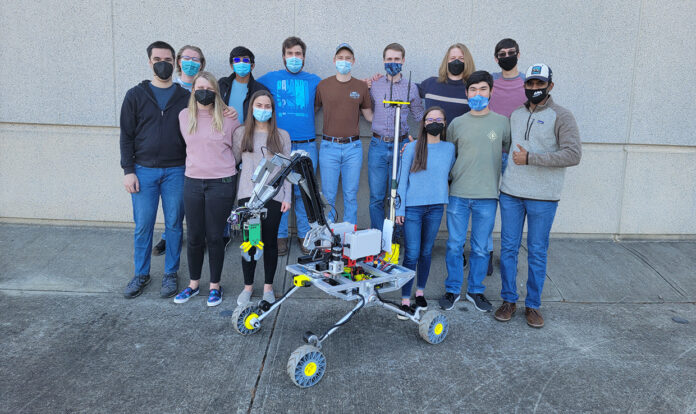A robotic rover developed for use on Mars by the University of Alabama in Huntsville’s (UAH) Space Hardware Club (SHC) will compete in the Mars Society’s University Rover Challenge (URC) finals in southern Utah this summer. The UAH rover called the Adaptable Service Transport Research Apparatus (ASTRA) passed a URC System Acceptance Review in the science category with a perfect score to advance to the competition.
The URC is the world’s premier robotics competition for college students and challenges student teams to design and build the next generation of Mars rovers that will one day work alongside astronauts exploring the red planet.
UAH’s 21-person SHC team has worked on ASTRA for two years. It is outfitted with a dexterous main arm and is equipped with cameras, a microscope, a spectrometer, and the hardware and chemicals needed to conduct tests to detect life on the red planet.
One of the reviewers commented, “This is one of the most impressive SAR submissions by a novice team I have ever seen.”
Under URC rules, the rover must fit inside a four-foot cube-shaped space on all sides but team lead Shelby Tull, a senior in aerospace engineering who founded the project, said the ASTRA gets taller when its antenna is deployed and weighs 103.4 pounds at its heaviest.
The search for life is one of ASTRA’s four missions.
“More specifically, it (ASTRA) has to look at rocks and soil and tell whether there is extant life, extinct life or no life,” said Tull. “The other missions are extreme retrieval and delivery involving picking up heavy objects and carrying them across difficult terrain, equipment servicing involving dexterous tasks like using a keyboard, and autonomous navigation.”
Using a vacuum and cyclonic separator, the rover can pick up either earthly dirt or Martian regolith and perform a bicinchoninic acid (BCA) test by adding a mixture of copper sulfate and BCA to the sample. If the chemicals turn purple, that indicates protein, which can only exist if there is extant life.
“We use our onboard spectrometer to look for pigments that are also only found with life, such as chlorophyll and carotenoids,” Tull said.
The rover has a rudimentary arm with a camera and a microscope to take a closer look at rock samples.
“We are really looking for endoliths and hypoliths – those are colonies of organisms that grow on, inside and underneath the rock,” Tull explained. “We might see streaks of green or gray, which indicate plant or bacterial life.”
For extinct life, the rover’s cameras allow the team to search out cast fossils and trace fossils.
“Cast fossils are what you usually think of when you think about a fossil, the actual shape of the organism petrified into rock,” Tull continued explaining ASTRA’s four missions. “Trace fossils are other things that organisms leave behind, such as footprints or nests.”
Primarily manually operated, ASTRA is also able to autonomously drive to Global Positioning System (GPS) waypoints over flat terrain using an onboard GPS sensor and magnetometer to drive to coordinates.
The team faced several design challenges, the main arm’s dexterity was one of them.
Advised by Dr. Gang Wang, an associate professor of mechanical and aerospace engineering, and Dr. Richard Tantaris, a mechanical and aerospace engineering lecturer, the SHC team is working to enable the rover to detect obstacles in its path so it can operate autonomously on rougher terrain.
“Getting it to be so dexterous didn’t really take much fine tuning at all, it was basically that good from when we first turned it all on!” said electrical lead Thomas Bennett, a graduate student in aerospace systems. “That’s not to say we just got lucky though. We really did our homework when designing it. We selected components and designed it from the beginning to have the best balance of strength and dexterity.”
Tull said for her the most challenging part of developing the device was designing the biosensor module used to detect life.
“We have no biology or chemistry majors on the team at this time, so we had to do a lot of homework to get it right,” she said. “It was very difficult to sort through scholarly research without being familiar with all the vocabulary used in biochemistry!”
The team was admittedly in uncharted territory in designing the spectrometer, which involved a lot of research in optics. One of the team members wrote an optical simulation program in MATLAB, which simulated the path that rays of light follow in the spectrometer and got it right to within 60 microns.
Most mechanical components were fabricated in the UAH Research Machine Shop under the guidance of Jim Buckley, prototype development specialist. Final assembly and all electronics work was done in the Space Hardware Club’s lab in UAH’s Optics Building.
“It was pretty challenging finding enough room to work, but I’d say we’ve managed it pretty nicely,” Tull said. “Space Hardware Club’s cage in the shop is full, and we have to share lab space with other Space Hardware Club projects, but working under difficult constraints is what engineers do.”
The design and refinement process hasn’t stopped as the team advances through the layers of URC review needed first before ASTRA can actually perform on the desert sand. Testing has revealed opportunities for improvement in the suspension, wheels and drivetrain.
“We’re hoping to end up with a suspension structure that’s trapezoidal instead of the triangle we have now, with larger wheels and more of a speed reduction between our motors and wheels,” Tull outlined.
The team is also working to enclose exposed electronics, fine-tune the camera placement and smooth operation through upgraded software.
Don’t miss out! Subscribe to our email newsletter to have all our smart stories delivered to your inbox.



